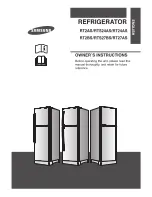
INSTALLATION INSTRUCTIONS
12
Electrical Requirements
Before you move your refrigerator into its final location, it is
important to make sure you have the proper electrical connection
Recommended Grounding Method
A 115 V, 60 Hz, AC only 15 or 20 A fused, grounded electrical
supply is required. It is recommended that a separate circuit
serving only your refrigerator and approved accessories be
provided. Use an outlet that cannot be turned off by a switch. Do
not use an extension cord.
NOTE:
Before performing any type of installation, cleaning, or
removing a light bulb, turn OFF Cooling, and then disconnect the
refrigerator from the electrical source. When you have finished,
reconnect the refrigerator to the electrical source and turn ON
Cooling. See “Using the Control(s)” Section.
Water Supply Requirements
A cold water supply with water pressure between 35 and 120 psi
(241 and 827 kPa) is required to operate the water dispenser and
ice maker. If you have questions about your water pressure, call
a licensed, qualified plumber.
NOTE:
If the water pressure is less than what is required, the flow
of water from the water dispenser could decrease or ice cubes
could be hollow or irregular shaped.
Reverse Osmosis Water Supply
IMPORTANT:
The pressure of the water supply coming out
of a reverse osmosis system and supplying the water inlet valve
of the refrigerator needs to be between 35 and 120 psi (241 and
827 kPa).
If a reverse osmosis water filtration system is connected to
your home cold water supply, the water pressure to the reverse
osmosis system needs to be a minimum of 40 to 60 psi (276 to
414 kPa).
■
Check to see whether the sediment filter in the reverse
osmosis system is blocked. Replace the filter if necessary.
■
Allow the storage tank on the reverse osmosis system to refill
after heavy use. The tank capacity could be too small to keep
up with the requirements of the refrigerator.
NOTE:
Faucet-mounted reverse osmosis systems are
not recommended.
■
If your refrigerator has a water filter, it may further reduce
the water pressure when used in conjunction with a reverse
osmosis system. Remove the water filter. See the “Water
Filtration System” section.
If you have questions about your water pressure, call a licensed,
qualified plumber.
Connect the Water Supply
Read all directions before you begin.
IMPORTANT:
■
Connect to potable water supply only.
■
Plumbing must be installed in accordance with the
International Plumbing Code and any local codes and
ordinances.
■
The gray water tubing on the back of the refrigerator (which
is used to connect to the household water line) is a PEX
(cross-linked polyethylene) tube. Copper and PEX tubing
connections from the household water line to the refrigerator
are acceptable, and will help avoid off-taste or odor in your
ice or water. Check for leaks.
Electrical Shock Hazard
Plug into a grounded 3 prong outlet.
Do not remove ground prong.
Do not use an adapter.
Do not use an extension cord.
Failure to follow these instructions can result in death,
fire, or electrical shock.
WARNING
Do not use with water that is microbiologically unsafe or
of unknown quality without adequate disinfection before
or after the system. Systems certified for cyst reduction
may be used on disinfected waters that may contain
filterable cysts.













































